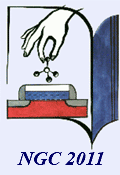
Nano and Giga Challenges
in Electronics, Photonics and Renewable Energy
Symposium and Summer School (Tutorial Lectures)
Moscow - Zelenograd, Russia, September 12-16, 2011


|
Nano and Giga Challenges in Electronics, Photonics and Renewable Energy Symposium and Summer School (Tutorial Lectures) Moscow - Zelenograd, Russia, September 12-16, 2011 |  |
Commentary Evgeni Gusev
On the Nano-Giga Initiative: During my professional career of a researcher and practitioner, I have been involved in organizing and participating in many scientific forums on different topics and of various formats ranging from small workshops to large international events. One could ask a valid question on what distinguishes the NGC forum from other similar international conferences. The answer is obviously subjective. To my taste (and, as we know, ”tastes differ”), there is a number of attributes that make the NGC projects quite interesting and attractive. First, it covers a wide range of topics and the list of topics usually reflects ”hot” areas of modern science and technology. Started as a nano/giga conference focusing mostly on micro- and nano-electronics, NGC has grown into other emerging areas such as renewable energy technologies, (nano)-photonics and others. Second, it brings together an interesting group of scientists including many invited speakers who are truly internationally recognized leaders in their fields. There is always something new to learn from them. Third, the format of the meeting consists of ”summer school” lectures given by world known scientists, focused technical sessions and posters. This combination allows one to customize your participation to your needs and interests. I personally like lectures at the summer school where I can learn about the ”latest and greatest” in the areas new to me. Interactive poster sessions are always enjoyable. Technical sessions during the symposium is a good opportunity for a ”deep-dive” into a specific area. Forth, publishing opportunities. Papers presented at the meeting could be published in recognized journals and booked by top tier publishers. Young researchers and students may find this particularly attractive. Fifth, there are business-type discussions organized for those interested in innovations and business aspects of high-technologies. Last but not least, interesting cultural program and sufficient time allowed for social events and networking which is quite important in the ”social mania” era we live in and very beneficial to initiate new professional collaborations. As a matter of fact, it is my observation that there is a ”NGC community” grown over these past 10 years since the first meeting in Moscow in 2002. Finally, for me being a ”Global Russian”, I value the Russian ”flavor” of the meeting. Historically, large number of Russian scientists from all over the globe tend to participate in the event which, by itself, is a good testimony of the role the Russian school of science continues to play at the international arena, let alone this allows good networking opportunity too. NGC will celebrate its 10th anniversary soon and still growing, a good evidence that the organizers are on the right track and the NGC idea is sustainable. On MEMS/NEMS (Micro/Nano-Microelectromechanical Systems): This fast growing area will be introduced and discussed in length in my lecture and upcoming review paper. Here, I just want to make a couple of brief (personal) statements. Why am I still excited about this fascinating field after joining it about 6 years ago? To me, it is a combination of: (i) ”relative” simplicity of the technology (e.g. compared to 10 nm CMOS); (ii) very interesting applications and growing product opportunities; and (iii) significant impact it makes on the way people use their devices and interact with each other and ”machines” around. Examples? Micro-accelerometers and gyroscopies in mobile phones. MEMS microphones. Microfluidic devices. Hundred thousands of human lives saved every year on the roads due to smart inertial measurement units, tire pressure sensors and stabilization units installed in cars. Every year brings new technologies and ”cool” applications. As to me personally, being part of a talented and diverse team of Qualcomm engineers and scientists developing mirasol, a revolutionary MEMS based reflective display technology, is a unique life-time experience and a privilege to commercialize a disruptive technology. This kind of opportunities doesn’t happen too often. On Russian science and scientists, and international collaboration: In my professional (and personal) life, I interact quite a bit with colleagues and friends in almost every ”corner” of the world. A common theme in these discussions it that Russian science, especially some branches such as physics, math, chemistry, bio, and so on, is still well regarded in the international community. Solid foundation of basic science and world-class scientific schools were built in the 20th century. The past couple of decades were quite ”rough” in Russia in terms of funding and under-appreciation of science and the profession. I am pleased to see that situation appears to be improving. There is a strategic direction at the government level to support and invest in innovations and rebuild many priority areas (e.g. energy, nanotechnologies, etc.). Some well know examples of such initiatives include Rusnano, Skolkovo. Funding is definitely important. At the same time, I am impressed with the new generation of young scientists and students who appear (at my first sight) to be independent, motivated and charged to accomplish big goals. Assuming that (i) funding trend from the government will continue, (ii) private sector will start to invest in mid- and long-term research, and (iii) talents will continue to grow, I am somewhat optimistic about Russia’s success on the innovative mission of its development. The road to it will be challenging and it will take years (likely decades) but the potential is there. International collaborations are important in today’s connected world. I encourage NGC participants to use various arenas and events at the Symposium and Summer school to establish new collaborations and friends, especially because the meeting will be held in Moscow, Russia this year. |
Empowered by Nano & Giga Solutions and NT-MDT
© 2010